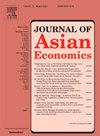中国不同收入水平城市女性的时间使用情况
IF 3.4
3区 经济学
Q1 ECONOMICS
引用次数: 0
摘要
本文分析了2017年中国时间使用调查的数据,以探讨家庭中女性时间分配的变化。研究结果揭示了中国女性在时间分配上的分层现象,不同收入水平家庭中的女性表现出不同的分工特征。在低收入家庭中,与男性相比,女性每天在有偿工作上的平均花费少1.296 h,但在无偿工作上的平均花费多2.439 h,在休闲上的平均花费少1.116 h,这表明了传统劳动分工的趋势。在中等收入家庭中,有偿工作时间的性别差距明显缩小,但女性每天的无偿工作时间平均多花费1.824 h,休闲时间平均少花费0.888 h,工作和家庭的双重负担更加沉重。在高收入家庭中,男女之间的时间分配基本上是平等的。随着家庭收入的增加,配偶在家庭分工中的比较优势的影响逐渐减弱。在中等收入家庭中,与配偶相比,议价能力更强的女性花在有偿工作上的时间更多。性别平等意识有效地促进了夫妻之间更平等地利用时间。本文章由计算机程序翻译,如有差异,请以英文原文为准。
Time use among urban women in China at different income levels
This paper analyzes data from the 2017 Chinese Time Use Survey to explore changes in women’s time allocation among households. The findings reveal a stratification phenomenon in the time allocation of Chinese women, with women in households of varying income levels exhibiting different labor division characteristics. In low-income households, women spend on average 1.296 h less per day on paid work compared to men, but 2.439 h more on unpaid work, and 1.116 h less on leisure, indicating a tendency towards a traditional division of labor. In middle-income households, the gender gap in paid work time has significantly narrowed, yet women still spend on average 1.824 h more per day on unpaid work and 0.888 h less on leisure, bearing a more severe double burden of work and family responsibilities. In high-income households, the time allocation between genders is largely equal. As household income rises, the comparative advantage of spouses in household labor division becomes less influential. In middle-income families, women with greater bargaining power than their spouses spend more time on paid work. Gender equality awareness effectively promotes more equal time use between husbands and wives.
求助全文
通过发布文献求助,成功后即可免费获取论文全文。
去求助
来源期刊

Journal of Asian Economics
ECONOMICS-
CiteScore
4.70
自引率
9.40%
发文量
90
期刊介绍:
The Journal of Asian Economics provides a forum for publication of increasingly growing research in Asian economic studies and a unique forum for continental Asian economic studies with focus on (i) special studies in adaptive innovation paradigms in Asian economic regimes, (ii) studies relative to unique dimensions of Asian economic development paradigm, as they are investigated by researchers, (iii) comparative studies of development paradigms in other developing continents, Latin America and Africa, (iv) the emerging new pattern of comparative advantages between Asian countries and the United States and North America.
 求助内容:
求助内容: 应助结果提醒方式:
应助结果提醒方式:


